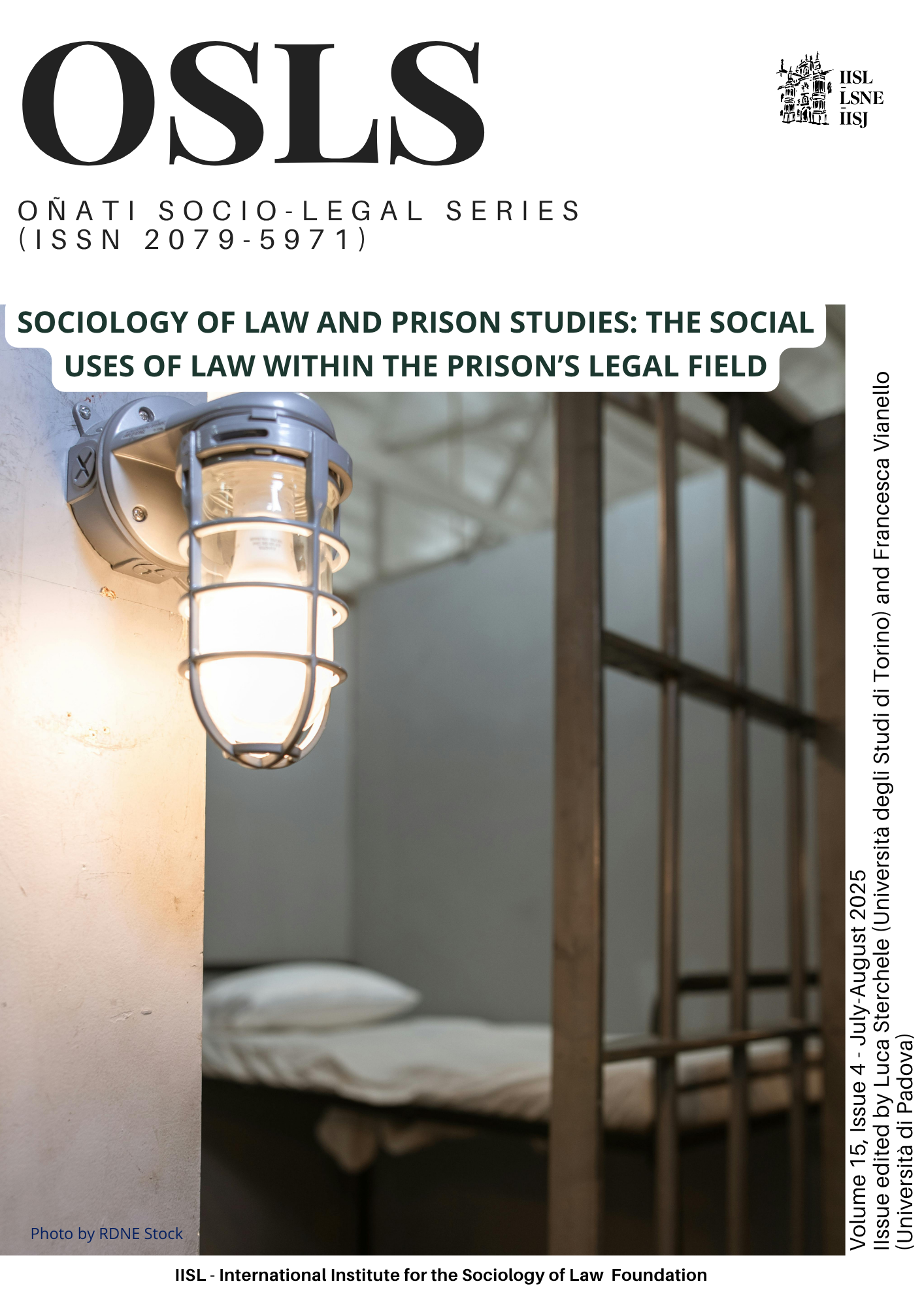Gangs, mafia, organised groups in prisons: the formal and informal strategies of managing the “public enemy"
Two cases-study between Global North and Global South
DOI:
https://doi.org/10.35295/osls.iisl.2076Palabras clave:
crimen organizado, regímenes penitenciarios especiales, mafia, bandas, desistimientoResumen
¿Qué influencia ejerce la etiqueta de “enemigo público” en las estrategias de gestión de prisiones? Utilizando hallazgos provenientes de investigaciones sobre el terreno realizadas en varios países (sobre todo, en prisiones para bandas del Triángulo Norte –El Salvador, Guatemala, Honduras– y en las unidades de “máxima seguridad” para miembros de la mafia en Italia), el artículo se centra en la relación forzada entre dos complejas organizaciones: el Estado y su aparato punitivo, por un lado, y los grupos organizados, el actor no estatal, por el otro. Los grupos organizados traen intramuros de la prisión su habitus, organización, liderazgo, jerarquía, símbolos, típicos de ese continuum. Las unidades especiales para presos peligrosos se están convirtiendo en una estrategia transnacional para experimentar con diferentes formas de relación entre el Estado y las organizaciones criminales: reconocimiento, degradación, deserción y el infravalorado desistimiento.
Descargas
Metrics
Estadísticas globales ℹ️
|
630
Visualizaciones
|
866
Descargas
|
|
1496
Total
|
|
Citas
Aebi, M.F., and Cocco, E., 2024. SPACE I - 2023 – Council of Europe Annual Penal Statistics: Prison populations, Strasbourg: Council of Europe. http://www.antoniocasella.eu/nume/Aebi_space-i_2023_5june2024.pdf
Agamben, G., 2003. Stato di eccezione : Homo sacer, 2., 1. Turin: Bollati Boringhieri.
Becker, H.S., 1963. Outsiders: studies in the sociology of deviance. London: The Free Press of Glencoe.
Best, D., 2019. Pathways to recovery and desistance: the Role of the Social Contagion of Hope. Cambridge: Policy Press. DOI: https://doi.org/10.21428/cb6ab371.0716185b
Brotherton, D.C., 2007. Beyond Social Reproduction. Bringing Resistance Back into the Theory of Gangs. Theoretical Criminology [online], 12(1), 55–77. Available at: https://doi.org/10.1177/1362480607085794 DOI: https://doi.org/10.1177/1362480607085794
Brotherton, D.C., 2015. Youth Street Gangs. A Critical Appraisal [online]. London: Routledge. Available at: https://doi.org/10.4324/9780203727782 DOI: https://doi.org/10.4324/9780203727782
Bugnon, G., 2020. Governing delinquency through freedom: control, rehabilitation and desistance [online]. London: Routledge. Available at: https://doi.org/10.4324/9780429466175 DOI: https://doi.org/10.4324/9780429466175
Cannon, L., 1999. Official negligence: how Rodney King and the riots changed Los Angeles and the LAPD. Boulder: Westview Press.
Carter, J.H., 2014. Gothic Sovereignty: Gangs and Criminal Community in a Honduran Prison. The South Atlantic Quarterly [online], 113(3). Available at: https://doi.org/10.1215/00382876-2692155 DOI: https://doi.org/10.1215/00382876-2692155
Cohen, S., 1973. Folk, Devil and Moral Panics: The creation of the Mods and Rockers. Urban Life and Culture, 2(3), 380–381. DOI: https://doi.org/10.1177/089124167300200308
Conquergood, D., 1997. Street Literacy. In: J. Flood, S.B. Heat and D. Lapp, eds., Handbook of Research on Teaching Literacy Through the Communicative and Visual Arts. New York: Simon & Schuster and Macmillan, 354–375.
Cruz, J.M., et al., 2017. La nueva cara de las pandillas callejeras: el fenómeno de las pandillas en El Salvador [online]. Miami: Florida International University. Available at: https://lacc.fiu.edu/research/the-street-gangs-in-central-america-research-initiative-scrain/la-nueva-cara-de-las-pandillas-callejeras-el-fenmeno-de-las-pandillas-en-el-salvador-esp.pdf
De Giorgi, A., 2010. Il governo dell’eccedenza. Postfordismo e il controllo della moltitudine. Verona: Ombre Corte.
Dudley, S., 2004. Walking Ghosts: Murder and Guerrilla Politics in Colombia [online]. London: Routledge. Available at: https://doi.org/10.4324/9780203499566 DOI: https://doi.org/10.4324/9780203499566
Garland, D., 2001. Culture of Control: Crime and Social Order in Contemporary Society. Oxford University Press. DOI: https://doi.org/10.7208/chicago/9780226190174.001.0001
Goffman, E., 1961. Asylums. New York: Doubleday.
Irwin, J., 1970. The Felon. Saddle River: Prentice-Hall.
Jump, D., 2020. The Criminology of Boxing, Violence and Desistance [online]. Bristol University Press. Available at: https://doi.org/10.1332/policypress/9781529203240.001.0001 DOI: https://doi.org/10.1332/policypress/9781529203240.001.0001
Kee, R., 2000. The Green Flag: A History of Irish Nationalism. London: Penguin Books.
Leverentz, A.M., 2014. Ex-Prisoner’s Dilemma: How Women Negotiate Competing Narratives of Reentry and Desistance. New Brunswick: Rutgers University Press.
Lupo, S., 2004. Storia della mafia. Dalle origini ai giorni nostri. San Mateo: Donzelli.
Martinez-Herrera, E., 2002. National Extremism and Outcomes of State Policies in the Basque Country, 1979–2001. International Journal on Multicultural Studies, 4(1).
Matthews, R., 2009. Doing Time. An Introduction to the Sociology of Imprisonment. London: Palgrave Macmillan.
Pratt, J., 2007. Penal Populism [online]. New York: Routledge. Available at: https://doi.org/10.4324/9780203963678 DOI: https://doi.org/10.4324/9780203963678
Salazar Ugarte, P., 2012. Crítica de la Mano Dura. Cómo enfrentar la violencia y preservar nuestras libertades. Mexico City: Océano.
Simon, J., 2007. Governing Through Crime: How the War on Crime Transformed American Democracy and Created a Culture of Fear [online]. Oxford University Press. Available at: https://doi.org/10.1093/oso/9780195181081.001.0001 DOI: https://doi.org/10.1093/oso/9780195181081.001.0001
Sozzo, M., 2023. Reading penalty from the periphery. Theoretical Criminology [online], 27(4), 660-675. Available at: https://doi.org/10.1177/13624806231199749 DOI: https://doi.org/10.1177/13624806231199749
Sparks, R., and Simon, J., eds., 2012. The SAGE Handbook of Punishment and Society. London: Sage.
Sutton, J.R., 2013. The Transformation of Prison Regimes in Late Capitalist Societies. American Journal of Sociology [online], 119(3), 715-746. Available at: https://doi.org/10.1086/675300 DOI: https://doi.org/10.1086/675300
Sykes, G.M., and Matza, D., 1957. Techniques of neutralization: A theory of delinquency. American Sociological Review [online], 22, 664–670. Available at: https://doi.org/10.2307/2089195 DOI: https://doi.org/10.2307/2089195
Varese, F., 2010. Organized Crime. Critical Concepts in Criminology. London: Routledge.
Weaver, B., 2019. Understanding desistance: a critical review of theories of desistance. Psychology, Crime & Law [online], 25(6), 641–658. Available at: https://doi.org/10.1080/1068316X.2018.1560444 DOI: https://doi.org/10.1080/1068316X.2018.1560444
Descargas
Publicado
Cómo citar
Número
Sección
Licencia
Derechos de autor 2025 Michele Miravalle

Esta obra está bajo una licencia internacional Creative Commons Atribución-NoComercial-SinDerivadas 4.0.
Los autores conservan el copyright de sus trabajos, que se publicarán en OSLS bajo una licencia Creative Commons Reconocimiento NoComercial SinObraDerivada. Puede consultar más detalles en: http://es.creativecommons.org/licencia/. Si no está de acuerdo con esta licencia, por favor, póngase en contacto con nosotros.
El autor concede los permisos necesarios para difundir la información bibliográfica del artículo, incluyendo el resumen, y autorizar a otros, incluyendo las bases de datos bibliográficas, de índices y servicios de alerta de contenidos, a copiar y comunicar esta información.
Para más información sobre los permisos para distribuir su artículo en cada fase de la producción, por favor, lea nuestra Política de Autoarchivo y Divulgación (en inglés).
Las condiciones de copyright con el nombre de autores y co-autores, y la licencia Creative Commons se mostrarán en el artículo. Estas condiciones se deben aceptar como parte del proceso de envío de un artículo a la revista. Por favor, asegúrese de que todos los co-autores se mencionan correctamente, y que entienden y aceptan estos términos.






















